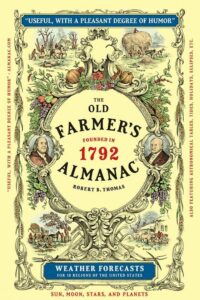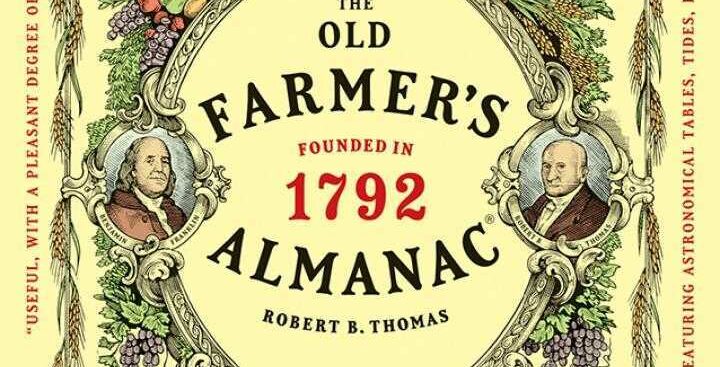Latest
A Brief History of the Farmer’s Almanac & Its Relevance in Climate Change

PanXchange Blog by Emily Shoemaker
Starting in 1792 during George Washington’s first term as president, The Old Farmers Almanac has become the longest-running periodical in United States history. While it has had a variety of topics and contributors over the years, it is primarily known for its weather predictions from a secret formula, witty humor, natural remedies, tides, a farming calendar, phenomena, helpful astronomy, and even lore. (An example of lore in this context would be to look out for puffy clouds on July 25th because that means we are in for lots of snow in the coming winter!)
It is most recognizable today by its yellow cover added in 1851 by artist Henry Nichols, highlighting the four seasons, the original editor Robert B. Thomas and a paralleled portrait of Benjamin Franklin. The portrait is a nod to Benjamin Franklin’s work as the “father of modern almanacs” through his own writings for amusement in Poor Richard’s Almanack running from 1732-1758. These Almanacs today read as a unifying space to share information and humor. They were a lot like blogs before blogs, being widely accessible, at about nine cents.
Robert B. Thomas was either very lucky or a genius. Even when his predictions were rightfully outrageous, the periodical persisted. In the Fall of 1815, it had forecasted snow for the following year’s July and August! This was an obviously embarrassing prediction and they tried to remove the publication from the public eye. Unfortunately, copies had already shipped globally. In 1816 Mount Tambora’s volcano erupted creating the year without summer. Robert B. Thomas had correctly predicted snow in July!
The Farmers Almanac was revolutionary for its time by separating the press from the editor, redefining the way information was created, and its uncanny ability to predict the unpredictable. What made the almanac what it was, was the formula that generated weather forecasts, which to this day is locked away in Dublin, New Hampshire. In 1938 when editor Roger Scaife took over and removed the weather forecasts to replace them with a more tangible recorded weather average, sales decreased by more than a half! The calendar was quickly returned.
Even now, in late 2021, as the climate crisis makes predicting weather harder and harder, The Old Famers Almanac persists. There is a new book for sale for the year 2022 on The Old Farmer’s Almanac Website, a free newsletter, blogs on the various interests within the almanac, all kinds of social media, and even a few podcasts. Admittedly, The Old Farmer’s Almanac might not be the primary source for farmers today, but it is a cheap resource with a strong history.
Currently, the Senior Editor of The Old Farmers Almanac, Sarah Perreault, claims the batting average for the annual almanac is still about 80% correct. Nowadays, they use a meteorologist for over a year prior to predicted weather events. The official almanac comes out annually around September 1st. Sarah says most people use the almanac today for events and planning their personal gardens for the next year. This would have been incredibly helpful for this writer’s garden as it is now mid-October, and my Halloween pumpkin has yet to turn orange.
The current push for socially responsible investing might not make The Old Farmer’s Almanac an essential source for farmers today. While much of the content asks us to look back at our history, we are now in unprecedented times without the luxury of relying on consistency in nature.
According to The Word Public Radio, “Extreme, record-breaking weather is happening around the world. Floods are drowning Europe and Asia, and unprecedented heat and drought have afflicted western North America, leading to historically low reservoirs and sparking wildfires that are destroying towns and degrading air quality for thousands of miles.” While we can appreciate the historical significance and community created by The Old Farmer’s Almanac, we are forced to look forward to combat the climate crisis. It will be a while before we can rely on the consistency of formulas and patterns in nature again.


